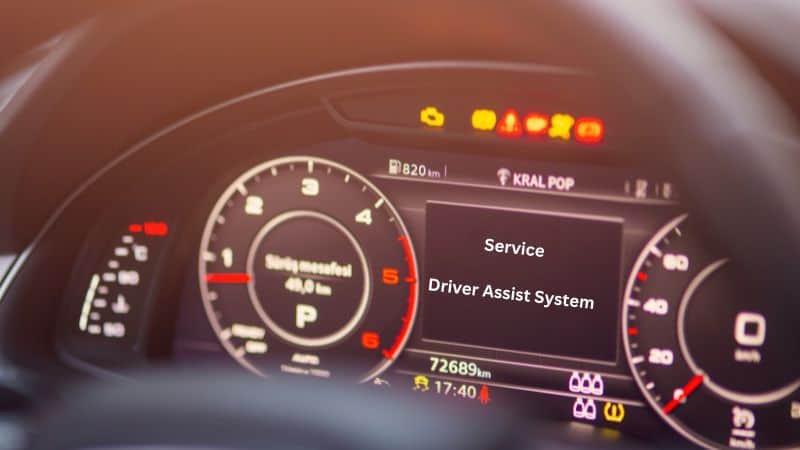You probably have a lot of questions. You’re curious about what it means and if there’s any danger right now. The most crucial thing to know is what causes the issue and how to resolve it. So, in this article, we will tell you the possible causes due to which issue appears and the solutions to solve this issue.
Modern cars are equipped with advanced driver assistance systems (ADAS), sometimes referred to as driver assistance or service driver aid systems, which provide complete control over your vehicle. The system is made up of electronically controlled parts that increase safety and comfort while driving, ultimately saving lives.

This is true because any incident involving a moving vehicle has the potential to impact not only the people within the car but also other drivers. Some types of driving assistance help in avoiding collisions, while others alert drivers to possible risks or mistakes. For instance, in an emergency, the automatic brake may engage and apply the brakes on the driver’s behalf if the driver does not use the brakes quickly enough.
What Causes the Service Driver Assist System Message?
Here are some of the main reasons why this issue occurs. Let’s have a look at these issues in detail.
1. Circuit Breakage or Shorting in the Haptic Seat Motor
As part of the Driver’s Assist System, the driver’s seat cushion can have two haptic motors: one on the left and one on the right. The output voltage required for them to function is provided by the seat memory control module. The motors may vibrate to warn you in specific situations. With prolonged use, their circuits could fail or have a short circuit. The most common cause of the service driver assist system notification is a broken haptic motor wire. Solving this kind of issue is often challenging. The message will typically not have a corresponding Diagnostic Trouble Code (DTC).
2. Faulty Steering Wheel
The steering wheel can sometimes trigger the notice to appear. The steering wheel is responsible for directing and controlling your car.

The alert will flash when ADAS detects an unstable or unreliable steering wheel. When you see the message, be sure to check the steering wheel whether it’s the Buick Envision or the Escalade service driver assist system.
3. Problem with the Software
Although it’s rare, some users have seen this warning without experiencing any apparent system malfunctions. It is a glitch in the software. Those facing this issue also reported that a DTC check produced no codes.
4. Faulty Module
A faulty adaptive cruise control module is another unusual but potential reason for the service driver assist system notice on your dashboard. Two modules are utilized by the driver assistance system; one is located beneath the front bumper cover and the other behind the rear bumper cover.
These modules assist in controlling adaptive cruise control, adaptive lighting, and collision warning. The alert on your dashboard may appear if the module malfunctions. Keep an eye out because this could still occur with the Chevy, GMC, and Cadillac service driver assistance systems.
Similar Dashboard Warnings:
- Rear Belt Monitor Fault on Ford
- Stop Vehicle Leave Engine Running
- Steering Assist Is Reduced Drive With Care
- Drive Carefully Systems Initializing
- Audi Parking Brake Malfunction
How to Fix Service Driver Assist System? 6 Easy Ways
The service driver assist system can be fixed as follows. These instructions are helpful for any car.
1. Diagnosis to identify the Issue
The quickest method to resolve a problem is to identify its root cause. When you insert a scan tool into your car’s OBD II port, various error codes should appear on the screen. Every error code indicates particular parts that are the source of the problem.
2. Inspect the Hepatic Seat Motor Circuit
To access the haptic motors, open the seat. Examine them carefully for any damaged or visibly worn-out wires. The issue is probably the wiring pigtail close to the seat motor. If so, the motor needs replacement. A common method for fixing pigtail wiring is to solder the wires together. That is risky even though it can save you money. In the future, it can lead to more complex problems. Use an OBD II scanner if you are unable to locate any wire breaks. This will include running a DTC check on the Memory Seat Module (MSM) of the car, which will control the left and right motors.
3. Eliminate Incorrect Codes
These error codes can sometimes appear randomly. Make sure there isn’t a mistake by clearing all codes using the scanner. Drive for some time and observe which code comes back. If none come back, there’s certainly a problem; if not, make the necessary fixes.
4. Inspect the Software Part
For approximately 15 minutes, disconnect the battery’s negative connection. After reconnecting the battery, make sure you have an OBD II scan tool to clear any engine fault codes.

All of your settings, including the memory seat module, must also be reset. Until the procedure is finished, Follow the instructions provided by the digital information center.
5. Replace the Steering Wheel
You might have to replace the steering wheel if it’s the cause of the problem. If your vehicle is still covered by warranty, your dealer needs to pay for the replacement.
6. Restart the System
You can also try resetting the driver assistance system to remove the notification. Every car has its own reset process. However, in a Ford, you can reset it by turning the ignition on and off while the vehicle is stationary. Closing and opening the door when your car is stopped is another method of reset. However, if the message was incorrect or you’ve fixed the driver assistance system’s bugs, then this might still work.
Conclusion
In addition to improving safety and saving lives, the service driver assist system also makes driving more comfortable. A haptic motor short circuit may be the cause of the message, but other possible causes include a malfunctioning steering wheel, module, or software bug. Using an OBD II scanner to diagnose the problem is the quickest method to find out why the notification appears.


![[FIXED] Service Driver Assist System: Meaning & Causes Service Driver Assist System](https://carstale.com/wp-content/uploads/service-driver-assist-system-1024x474.jpg)